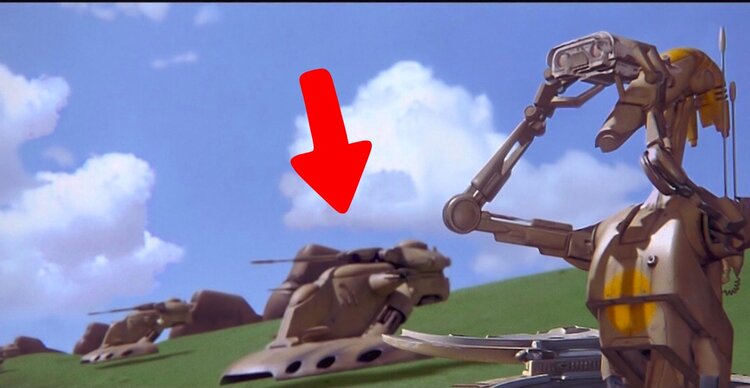The AAT is one of the stand-out assault vehicles around the time of the Clone Wars. This tank ultimately became the main infantry support vehicle for the Separatists. So, why was it outfitted as a droid, instead of using droid pilots? The time of production, cost, and nature of the Confederacy all help address this question.
Pre-Clone Wars Weaponry
The AAT battle tank, as Ahsoka described, had a “pilot in the front hatch” who operated the tank, short-range blasters, and the shells. It also had a “commander in the top hatch” who controlled the main cannon and the turret. In other words, it wasn’t a droid vehicle.
A primary reason why is that this military vehicle was produced before the Clone Wars. Baktoid Armor Workshop designed and manufactured the AAT for the Trade Confederation’s invasion of Naboo. It was also donated to the Separatist Confederacy. This battle tank was produced during a time when mobile weaponry was purposely designed to be manually operated.
The AAT relied on a four-person crew to drive the vehicle and fire its weapons, usually B-1 battle and pilot droids. Sometimes, BX series droid commandos or organics served as tank commanders. But the vehicle was made to have a crew, not to be a droid itself. As a repulsorlift vehicle, the AAT was built in factories geared toward that type of production.
Fans here discuss the timing factor for explaining why the AAT was not a droid, but also how many Confederacy member worlds wouldn’t have “substantial droid armies or control ships.” Hence, it was a better option for them to use “biological pilots” even as the wars commenced.
The MTT falls into a similar category, as it was manufactured by Baktoid for the Trade Confederation. This vehicle also lived in to be used in the Clone Wars, including transporting B-2 super battle droids.
So, a combination of timing and logistics helps explain why the AAT and MTT were not droid vehicles.
Logistics and Economics
Building on the logistical side, the AAT preceded the droid army and was meant to accompany them into battle. These frontline assault tanks served to anchor “the droid armies’ heavy infantry.” Likewise, with the mass production of battle droids, it made logistical sense to keep the original design and rely on the B1s to operate it.
It also made economic sense to use the B1s. It was certainly cheaper to produce and maintain the battle droids than to repurpose and reproduce the AATs. As we may know, battle droids were purposely made to be easily replaced. As a fan commented here, they were “the ultimate in disposable hardware”, very deployable and versatile, and inexpensive.
This cost component appealed to the Trade Federation. We recall that the Federation was motivated to build its Droid Army because of “their cheap price, their lack of a need for food or living quarters,” and their obedient programming. It made sense to extend the economic value and use them to operate vehicles too.
Since the B1s could also maintain the AATs, they provided yet further value and helped keep costs down. Relatedly, using a crewed vehicle was cheaper to repair than replacing a more expensive assault vehicle.
The Nature of the CIS
Many of the points above resonate with the nature of the Confederacy of Independent Systems. As a collection of “disgruntled star systems,” the CIS operated autonomously and sourced its warmaking abilities from various sources.
Accordingly, only some of the weaponry, like the vulture droids, were unmanned models. The vultures were a primary type of droid starfighters that were made to operate without a crew. Yet, many of the Separatist supporters preferred otherwise or drew on their local situations for weaponry.
The Essential Guide to Warfare book helps peel back the layers of how the Clone Wars were fought. It reveals how most planetary defenses and battles didn’t consist of droid and clone armies against one another. On a similar note, most of the off-screen battles didn’t feature the latest technology with unmanned vehicles.
The Umbaran militia provides us with a good example of local forces relying on their own vehicles in battle. Their hover tanks relied on a pilot, as did the crawler tanks. The lack of uniformity across the Separatist units serves as a better description for assault vehicles.
The AAT as a Manned Vehicle
Several reasons coalesce to indicate why the AAT originated and remained a manned assault vehicle. The timing, logistics, economics, and nature of the CIS convey why this type of vehicle and others were the preferred choice among many of the Separatist combatants.

